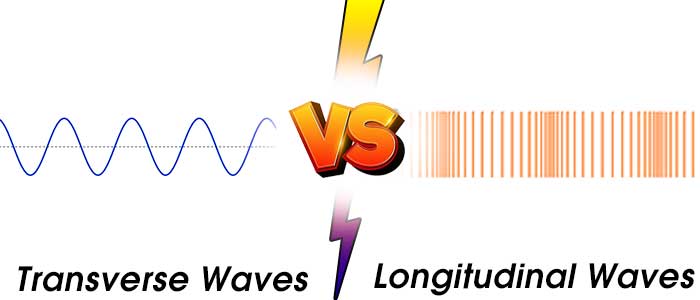How to Use Design Principles to Boost Your YouTube Channel's Appeal

Understanding the differences between longitudinal and transverse waves is essential in various scientific fields, from physics and engineering to telecommunications and music. It's crucial for comprehending the nature of waves and their practical applications in our daily lives.
Waves: Introduction and Types
A wave is a transfer of energy through a medium from one point to another. Some examples of waves include; water waves, sound waves, and radio waves. Waves come in two different forms; a Transverse Wave which moves the medium perpendicular to the wave motion, and a Longitudinal Wave, which moves the medium parallel to the wave motion.
All waves dont have the same effect on a medium. The energy in heat waves and sound waves produces two different types of waves, called transverse waves and longitudinal waves. You can identify the type of wave passing through a medium by the way the medium is disturbed.
The difference between transverse and longitudinal waves is the direction in which the waves shake. If the wave shakes perpendicular to the movement direction, it's a transverse wave, if it shakes in the movement direction, then it's a longitudinal wave.
Transverse Wave
Transverse waves are waves where the direction of vibrations is at 90° to the direction in which the wave travels. A wave whose particles oscillate perpendicular to the direction that the wave travels. The wave is moving left to right, while the disturbance moves up and down. The disturbance moves perpendicular to the direction of the wave. Transverse waves create light.

It is easy to imagine a transverse wave.The waves transmitted from a tightened rope when shaken are transverse waves. Waves are generated by the vibration of matter. In the case of the rope, the vibration of the rope itself. When the vibration direction is perpendicular to the wave movement direction, it is called a transverse wave. In the exhibit, parallel horizontal rods like a centipede legs are shaken up and down, transmitting waves. As the wave's movement direction and the rod's shaking direction are perpendicular, it demonstrates that those are transverse waves.
In a Transverse wave the Crest and Troughs are the locations of maximum displacement up or down. The Amplitude is the measurement of maximum displacement. The Wavelength is the distance of one complete wave cycle. For example; the distance from crest to crest or trough to trough would be 1 wavelength.

Examples of Transverse waves
Examples of Transverse waves would be a vibrating guitar string or electromagnetic waves.
Longitudinal Wave
Examples of Longitudinal waves
Longitudinal waves are waves where the vibrations of the particles are along the direction in which the wave travels. A wave whose particles oscillate in the same direction as the wave travels.

It's quite difficult to imagine a longitudinal wave. The exhibit demonstrates longitudinal waves using a 10m spring. By looking closely at the exhibit, you can see that when the spring is pressed, transmission occurs at the short part of intervals. You can see the spring's stripe pattern moving. Those stripes movements are waves. Because the image is different from a typical wave, it is difficult to call them waves as such.
Longitudinal waves are also known as compression waves. That name better represents what actually happens. As one can see in the movement of the exhibit, the 'loose' part and 'tight' part are transmitted as part of the nature of the longitudinal waves. In the case of longitudinal waves the wave direction is vertical, which is why the name longitudinal was adopted.
In a Longitudinal wave, areas of maximum displacement are known as Compressions and Rarefactions. The stronger the wave, the more compressed and spread out the wave medium becomes.

Example of a Longitudinal wave would be a “Slinky” wave that you push and pull.
Transverse vs Longitudinal Waves
| S.No. | Transverse waves | Longitudinal waves |
| 1 | Displacements of the particles are perpendicular to the direction of propagation of the wave. | Displacements of the particles are along the direction of propagation of the wave. |
| 2 | Transverse waves look as crests and troughs propagating in the medium. | Longitudinal waves give the appearance of alternate compressions and rarefaction moving forward. |
| 3 | Transverse waves can only be transmitted in solids or on the surface of the liquids. | Longitudinal waves can travel in solids, liquids and gases. |
| 4 | In case of a transverse wave, the displacement - distance graph gives the actual picture of the wave itself. | In case of longitudinal waves, the graph only represents the displacement of the particles at different points at a given time. |
| 5 | Transverse waves produce light. | Longitudinal waves produce sound. |
| 6 | Example of Transverse Wave: Water waves. | Example of Longitudinal Wave: Sound waves, ultrasound waves. |
| 7 | When a transverse wave passes through a medium, it looks like a moving snake. | When a longitudinal wave passes through a medium, it looks more like a traveling earthworm. |
| 8 | On a transverse wave, wavelength is the distance between two consecutive crests, or two consecutive troughs. | The wavelength of a longitudinal wave is the distance between two consecutive compressions, or two consecutive rarefactions. |
Common Characteristics of Both Wave Types:
Wavelength
Wavelength is the distance between two consecutive points in a wave that are in phase with each other. For longitudinal waves, this is the distance between two consecutive compressions or rarefactions. For transverse waves, it's the distance between two crests or two troughs.
Frequency
Frequency is the number of complete cycles (or oscillations) a wave undergoes per unit of time. It's measured in Hertz (Hz).
Amplitude
The amplitude of a wave is the maximum displacement of particles from their resting position. In a transverse wave, it's the distance from the crest (or trough) to the resting position. In a longitudinal wave, it's the maximum compression or rarefaction from the equilibrium.
Propagation
Both types of waves propagate energy and information through the medium without permanently displacing the particles. The medium oscillates in response to the passage of the wave, and energy is transmitted through the wave's motion.
Are earthquakes longitudinal or transverse waves?
Earthquakes are longitudinal and transverse waves. An earthquake is the transmission of a tremor occurring at an epicenter. Earthquakes become waves, which spread, shaking the ground. Earthquakes create both longitudinal and transverse waves. Also, one characteristic is that a longitudinal wave's transmission is faster than transverse waves. If the longitudinal wave of an earthquake is called the P wave, it is the initial tremor before the big tremor. If the transverse wave is called the S wave, it is the big tremor after the initial tremor.
Both transverse and longitudinal waves occur in solids such as metals and rocks.
Why light is a transverse wave?
Light also has waves characteristics. Not longitudinal waves, but transverse waves. As evidence of transverse waves, a phenomenon called light polarization occurs. The length of a wave may reveal the characteristics of that wave. In the case of the ocean waves, the wave length is the distance between wave crest and wave crest.
In the case of light, the difference of wave length is the difference of color. The long waves in light waves are red, and the short waves are blue. The human eye cannot see longer wave lengths than red such as infrared rays and electromagnetic waves. Waves with length shorter than blue are ultraviolet rays, x-rays and gamma rays.
Tags:
Difference between Longitudinal Waves vs Transverse
Transverse vs Longitudinal Waves
Differences between Longitudinal Waves vs Transverse
Image Credits: Freepik








